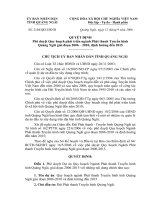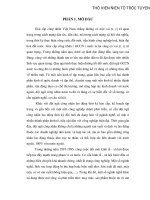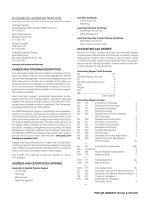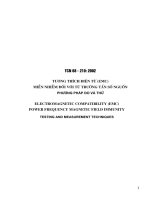KEYGCSE 210
Bạn đang xem bản rút gọn của tài liệu. Xem và tải ngay bản đầy đủ của tài liệu tại đây (75.53 KB, 5 trang )
SƠ GD&ĐT VINH PHUC
TRƯƠNG THPT LIỄN SƠN
(Đề thi gồm: 05 trang)
ĐỀ KSCL ÔN THI THPT QG NĂM HỌC 2019-2020
BÀI THI MƠN: TIẾNG ANH 210
Thời gian làm bài: 60 phút, khơng kể thời gian phát đề
Ho va tên thi sinh:……………………………………………………………………. SBD:…………………………
Mark the letter A, B, C, or D on your answer sheet to indicate the word that differs from the
other three in the position of primary stress in each of the following questions.
Question 01. A. community B. particular
C. mathematics
D. authority
Question 02. A. explanation B. experiment
C. accomplishment D. discovery
Mark the letter A, B, C, or D on your answer sheet to indicate the underlined part that needs
correction in each of the following questions.
Question 03. If you want to borrow my car, promise to drive careful.
A. you
B. borrow
C. promise
D. careful
Question 04. It is important that cancer is diagnosed and treated as early as possible in order to
assure a successful cure.
A. is
B. as early as possible
C. assure
D. cure
Question 05. Paris has been well-known about its famous monuments, beautiful music, and
wonderful restaurants for over 100 years.
A. has
B. well-known about
C. beautiful D. for over
Mark the letter A, B, C, or D on your answer sheet to indicate the correct answer to each of the
following questions.
Question 06. She can't marry her cousin__________ she loves him.
A. though
B. so
C. despite
D. because
Question 07. __________ Europe and Asia are coming to rely more and more on__________ nuclear
generation.
A. An/ a
B. 0/ 0
C. The/ the
D. The/ a
Question 08. I don’t agree with__________ very young and pretty criminals
A. committing
B. enforcing
C. imprisoning
D. offending
Question 09. What beautiful eyes___________!
A. does she have
B. she has
C. has she
D. she doesn't have
Question 10. __________ long, I'm sure you will be speaking English__________ a native speaker.
A. After/ like
B. Before/ like
C. After/ for
D. Before/ for
Question 11. He's left his book at home; he's always so___________.
A. forgetful
B. forgettable
C. forgotten
D. forgetting
Question 12. We are going to build a fence around the field with__________ to breeding sheep and cattle.
A. a goal
B. an outlook
C. a reason
D. a view
Question 13. The meeting didn’t__________ until late.
A. end up
B. break up
C. come aboutD. fall through
Question 14. Fiona is very angry__________ her boss’s decision to sack several members of staff.
A. against
B. by
C. for
D. about
Question 15. Media reports on the outcome of military intervention often__________ the true facts.
A. divert
B. detract
C. depose
D. distort
Question 16. He hurried__________ he wouldn't be late for class.
A. since
B. as if
C. unless
D. so that
Question 17. When his parents are away, his oldest brother__________.
A. knocks it off
B. calls the shots
C. draws the line
D. is in the same boat
Question 18. If he had been more careful, he__________.
A. won’t fall
B. wouldn’t fall
C. wouldn’t have fallen
D. would haven’t fallen
Question 19. We should participate in the movements__________ the natural environment.
A. organizing to conserve
B. organized conserving
C. which organize to conserve
D. organized to conserve
Mark the letter A, B, C, or D on your answer sheet to indicate the most suitable response to
complete each of the following exchanges.
Question 20. Jenny: “Thank you very much for your donation, Mr. Robinson.”
- Mr. Robinson: “________________________”
A. You can say that again.
B. I see.
C. You are right.
D. Delighted I was able to help.
Question 21. John: “Well it was nice talking to you, but I have to dash.” Jane: “________________”
A. Well, another time.
B. Yes, I enjoyed talking to you, too.
C. OK, see you.
D. That's nice.
Mark the letter A, B, C, or D on your answer sheet to indicate the word(s) CLOSEST in meaning
to the underlined word(s) in each of the following questions.
Question 22. I am glad I was able to be there for my friend when her mom died..
A. to offer support in time of need for
B. to cry with
C. to travel with
D. to visit
Question 23. The sign indicates the correct direction to the store.
A. looks
B. shows
C. says
D. needs
Mark the letter A, B, C, or D on your answer sheet to indicate the word(s) OPPOSITE in
meaning to the underlined word(s) in each of the following questions.
Question 24. It is relatively easy to identify the symptoms of the peculiar disease.
A. evidently
B. absolutely
C. comparatively
D. obviously
Question 25. When you consider all the advantages you've gained I think you'll admit you had a
good run for your money.
A. a lot of loss from your money
B. a lot of benefits from your money
C. a lot of advantages from your money
D. a lot of failures in making your money
Mark the letter A, B, C, or D on your answer sheet to indicate the sentence that is closest in
meaning to each of the following questions.
Question 26. I whispered as I didn’t want anybody to hear our conversation.
A. So as not to hear our conversation I whispered.
B. Since nobody wanted to hear our conversation I whispered.
C. Because I whispered, nobody heard our conversation.
D. I lowered my voice in order that our conversation couldn’t be heard.
Question 27. Though he tried hard, he didn’t succeed.
A. However he tried hard, he didn’t succeed.
B. However hard he tried, he didn’t succeed.
C. However he didn’t succeed hard, he tried hard.
D. However he tried hard, but he didn’t succeed.
Question 28. “If you keep eating so much fat, you’ll gain weight.” said his mother.
A. His mother suggested him gaining weight if he kept eating so much fat.
B. His mother warned him that he would gain weight if he kept eating so much fat.
C. His mother threatened him to gain weight if he kept eating so much fat
D. His mother complained about his gaining weight if he kept eating so much fat.
Mark the letter A, B, C, or D on your answer sheet to indicate the sentence that best combines
each pair of sentences in the following questions.
Question 29. He was suspected to have stolen credit cards. The police have investigated him for days.
A. He has been investigated for days, suspected to have stolen credit cards.
B. Suspecting to have stolen credit cards, he has been investigated for days.
C. Having suspected to have stolen credit cards, he has been investigated for days.
D. Suspected to have stolen credit cards, he has been investigated for days.
Question 30. Crazianna is a big country. Unfortunately, it has never received respect from its neighbours.
A. Though Crazianna is a big country, it has never received respect from its neighbours.
B. Crazianna has never received respect from its neighbours because it is a big country.
C. It is Crazianna, a big country, that has never received respect from its neighbours.
D. Crazianna is such a big country that it has never received respect from its neighbours.
Read the following passage and mark the letter A, B, C, or D on your answer sheet to indicate
the correct word or phrase that best fits each of the numbered blanks.
How men first learnt to (31)_________ words is unknown; in other words, the origin of
language is a mystery. All we really know is that men, unlike animals, (32)_________ invented certain
sounds to express thoughts and feelings, actions and things so that they could communicate with
each other; and that later they agreed (33)_________ certain signs, called letters, which could be
combined to represent those sounds, and which could be written down. These sounds, whether
spoken or written in letters, are called words.
Great writers are those who not only have great thoughts but also express these thoughts
in words that (34)_________ powerfully to our minds and emotions. This charming and telling use of
words is what we call literary style. Above all, the real poet is a master of words. He can convey his
meaning in words which sing like music, and which by their position and association can
(35)_________ men to tears. We should, therefore, learn to choose our words carefully, or they will
make our speech silly and vulgar.
Question 31. A. invent
B. create
C. make
D. discover
Question 32. A. whatever
B. however
C. somewhat
D. somehow
Question 33. A. at
B. upon
C. for
D. in
Question 34. A. interest
B. appeal
C. attract
D. lure
Question 35. A. take
B. send
C. break
D. move
Mark the letter A, B, C, or D on your answer sheet to indicate the word whose underlined part
differs from the other three in pronunciation in each of the following questions.
Question 36. A. easy
B. sea
C. learn
D. eat
Question 37. A. park
B. yard
C. card
D. carry
Read the following passage and mark the letter A, B, C, or D on your answer sheet to indicate
the correct answer to each of the questions.
THE DIGITAL DIVIDE
Information technology is influencing the way many of us live and work today. We use the
Internet to look and apply for jobs, shop, conduct research, make airline reservations, and explore
areas of interest. We use e-mail and the Internet to communicate instantaneously with friends and
business associates around the world. Computers are commonplace in homes and the workplace.
Although the number of Internet users is growing exponentially each year, most of the
world’s population does not have access to computers or the Internet. Only 6 percent of the
population in developing countries are connected to telephones. Although more than 94 percent
of U.S. households have a telephone, only 42 percent have personal computers at home and 26
percent have Internet access. The lack of what most of us would consider a basic communications
necessity –the telephone –does not occur just in developing nations. On some Native American
reservations only 60 percent of the residents have a telephone. The move to wireless connections
may eliminate the need for telephone lines, but it does not remove the barrier to equipment costs.
Who has Internet access? Fifty percent of the children in urban households with an income
over $75,000 have Internet access, compared with 2 percent of the children in low-income, rural
households. Nearly half of college-educated people have Internet access, compared to 6 percent of
those with only some high school education. Forty percent of households with two parents have
access; 15 percent of female, single-parent households do. Thirty percent of white households, 11
percent of black households, and 13 percent of Hispanic households have access. Teens and children
are the two fastest-growing segments of Internet users. The digital divide between the populations
who have access to the Internet and information technology tools is based on income, race, education,
household type, and geographic location. Only 16 percent of the rural poor, rural and central city
minorities, young householders, and single parent female households are connected.
Another problem that exacerbates these disparities is that African-Americans, Hispanics,
and Native Americans hold few of the jobs in information technology. Women hold about 20
percent of these jobs and are receiving fewer than 30 percent of the computer science degrees.
The result is that women and members of the most oppressed ethnic groups are not eligible for
the jobs with the highest salaries at graduation. Baccalaureate candidates with degrees in
computer science were offered the highest salaries of all new college graduates in 1998 at
$44,949.
Do similar disparities exist in schools? More than 90 percent of all schools in the country are
wired with at least one Internet connection. The number of classrooms with Internet connections
differs by the income level of students. Using the percentage of students who are eligible for free lunches
at a school to determine income level, we see that nearly twice as many of the schools with more
affluent students have wired classrooms as those with high concentrations of low-income students.
Access to computers and the Internet will be important in reducing disparities between
groups. It will require greater equality across diverse groups whose members develop knowledge
and skills in computer and information technologies. If computers and the Internet are to be used
to promote equality, they will have to become accessible to populations that cannot currently
afford the equipment which needs to be updated every three years or so. However, access alone is
not enough. Students will have to be interacting with the technology in authentic settings. As
technology becomes a tool for learning in almost all courses taken by students, it will be seen as a
means to an end rather than an end in itself. If it is used in culturally relevant ways, all students
can benefit from its power.
Question 38. Why does the author mention the telephone in paragraph 2?
A. To contrast the absence of telephone usage with that of Internet usage
B. To describe the development of communications from telephone to Internet
C. To demonstrate that even technology like the telephone is not available to all
D. To argue that basic telephone service is a first step to using the Internet
Question 39. Why does the author give details about the percentages of Internet users in paragraph 3?
A. To argue for more Internet connections at all levels of society
B. To suggest that improvements in Internet access are beginning to take place
C. To prove that there are differences in opportunities among social groups
D. To explain why many people have Internet connections now
Question 40. According to paragraph 4, why are fewer women and minorities employed in the
field of computer technology?
A. They do not have an interest in technology.
B. They prefer training for jobs with higher salaries.
C. They are not admitted to the degree programs.
D. They do not possess the educational qualifications.
Question 41. The word “concentrations” in the passage is closest in meaning to_________.
A. confidence
B. protections
C. numbers
D. support
Question 42. What can be inferred from paragraph 6 about Internet access?
A. The cost of replacing equipment is a problem.
B. Technology will be more helpful in three years.
C. Better computers need to be designed.
D. Schools should provide newer computers for students.
Read the following passage and mark the letter A, B, C, or D on your answer sheet to indicate
the correct answer to each of the questions.
Cooperation is the common endeavor of two or more people to perform a task or reach a
jointly cherished goal. Like competition and conflict, there are different forms of cooperation,
based on group organization and attitudes.
In the first form, known as primary cooperation, group and individual fuse. The group
contains nearly all of each individual’s life. The rewards of the group’s work are shared with each
member. There is an interlocking identity of individual, group and task performed. Means and
goals become one, for cooperation itself is valued.
While primary cooperation is most often characteristic of pre-literature societies,
secondary cooperation is characteristic of many modern societies. In secondary cooperation,
individuals devote only part of their lives to the group. Cooperation itself is not a value. Most
members of the group feel loyalty, but the welfare of the group is not the first consideration.
Members perform tasks so that they can separately enjoy the fruits of their cooperation in the
form of salary, prestige, or power. Business offices and professional athletic teams are examples of
secondary cooperation.
In the third type, called tertiary cooperation or accommodation, latent conflict underlies the
shared work. The attitudes of the cooperating parties are purely opportunistic: the organization is
loose and fragile. Accommodation involves common means to achieve antagonistic goals: it
breaks down when the common means cease to aid each party in reaching its goals. This is not,
strictly speaking, cooperation at all, and hence the somewhat contradictory term antagonistic
cooperation is sometimes used for this relationship.
Question 43. What is the author’s main purpose in the first paragraph of the passage?
A. To offer a brief definition of cooperation
B. To explain how cooperation differs from competition and conflict
C. To urge readers to cooperate more often
D. To show the importance of group organization and attitudes
Question 44. The word cherished in paragraph 1 is closest in meaning to_________.
A. agreed on
B. prized
C. defined
D. set up
Question 45. Which of the following statements about primary cooperation is supported by
information in the passage?
A. It is an ideal that can never be achieved
B. It was confined to prehistoric times
C. It is usually the first stage of cooperation achieved by a group of individuals attempting to cooperate
D. It is most commonly seen among people who have not yet developed reading and writing
skills
Question 46. According to the passage, why do people join groups that practice secondary
cooperation?
A. To get rewards for themselves C. To experience the satisfaction of cooperation
B. To defeat a common enemy
D. To associate with people who have similar backgrounds
Question 47. Which of the following is an example of the third form of cooperation as it is defined
in the fourth paragraph?
A. Members of a farming community share work and the food that they grow
B. Two rival political parties temporarily work together to defeat a third party
C. Students form a study group so that all of them can improve their grades
D. A new business attempts to take customers away from an established company
Question 48. Which of the following is NOT given as a name for the third type of cooperation?
A. Accommodation
B. Latent conflict
C. Tertiary cooperation
D. Antagonistic cooperation
Question 49. The word fragile in paragraph 4 is closest in meaning to_________.
A. poorly planned B. involuntaryC. inefficient
D. easily broken
Question 50. Which of the following best describes the overall organization of the passage?
A. The author presents the points of view of three experts on the same topic
B. The author compares and contrasts two types of human relations
C. The author describes a concept by analyzing its three forms
D. The author provides a number of concrete examples and then draws a conclusion
__________HẾT_________









